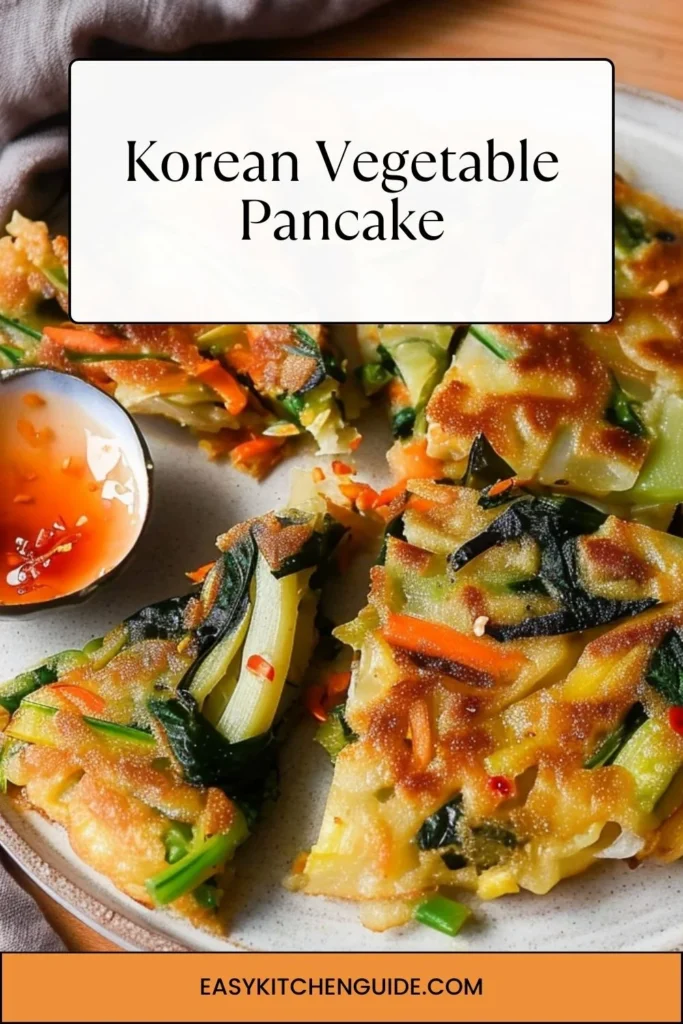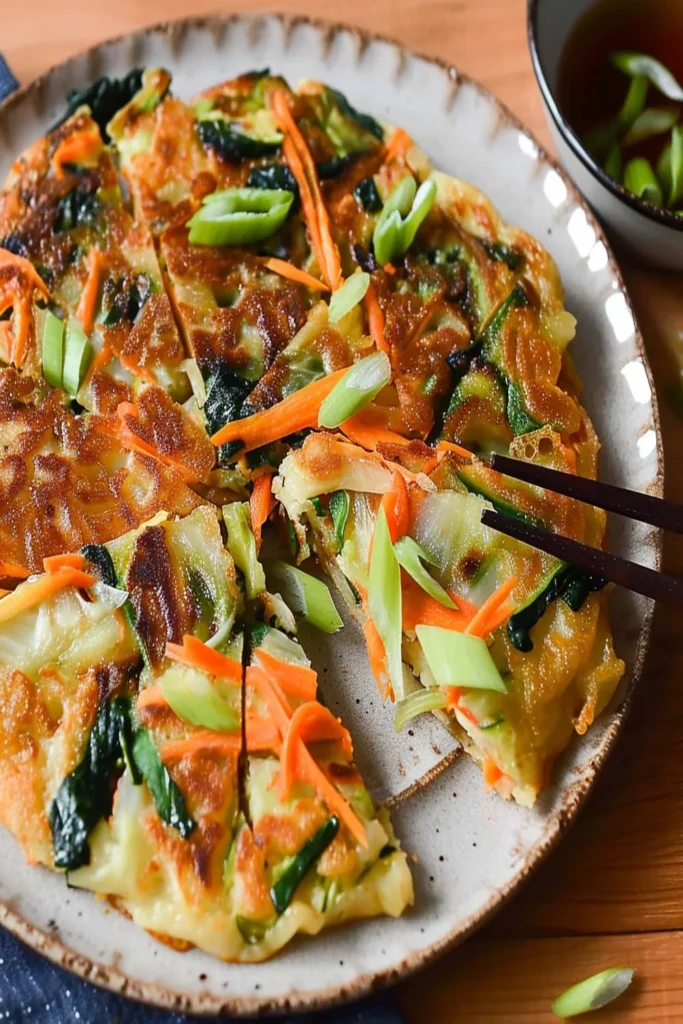Korean vegetable pancake (or buchimgae) is a popular Korean savory pancake that is usually served as a side dish or appetizer.
This pancake is made from a batter of eggs, vegetables, and flour, and is cooked in a skillet until golden and crispy. It is a popular street food in Korea and is also served in restaurants and homes. It’s a versatile dish that can be enjoyed as a snack, appetizer, or as part of a meal.
In this article, we’ll take a look at what Korean vegetable pancake is, its ingredients, how to make it, and some of the variations and tips to make it the best it can be. We’ll also discuss how to store and serve it, as well as some nutrition information. Let’s dive in!

What is a Korean Vegetable Pancake?
Korean vegetable pancake is a savory pancake made from a batter of eggs, vegetables, and flour. The vegetables used can vary but typically include green onions, carrots, zucchini, mushrooms, and kimchi.
The batter is then cooked in a skillet until golden and crispy. The pancake is often served as a side dish or appetizer, but can also be enjoyed as a snack or as part of a meal.
What Does it Taste Like?
Korean vegetable pancake has a savory and slightly sweet flavor. The vegetables provide a crunchy texture, while the egg and flour in the batter help bind everything together.
The pancakes are often served with a dipping sauce, such as soy sauce or gochujang (Korean chili paste). The sauce helps to add a bit more flavor and spice to the dish.
You’ll also like the following Soup recipes!
Ingredients
Batter:
- 2 cups all-purpose flour (260g): All-purpose flour is the main dry ingredient in the batter, providing structure and thickness to the pancakes.
- 4 tablespoons cornstarch or potato starch: Cornstarch or potato starch adds a light and crispy texture to the batter, ensuring the pancakes are not too dense and have a delightful crunch.
- Avocado oil or any neutral oil for cooking: Neutral oil is used for cooking the pancakes, providing a medium for frying and contributing to the overall flavor. Avocado oil, with its mild taste, is a suitable choice.
- 2 teaspoons garlic powder: Garlic powder imparts a savory and aromatic flavor to the batter, enhancing the overall taste of the pancakes.
- 1.5 teaspoons salt: Salt is a crucial seasoning, balancing the flavors in the batter and bringing out the taste of the vegetables.
- 2 cups cold water: Cold water is used to create the batter, ensuring the right consistency for coating the vegetables and achieving the desired pancake texture.
Vegetables (5 cups total):
- 2 cups grated and squeezed zucchini (240g): Zucchini adds moisture and a mild, earthy flavor to the pancakes. Grating and squeezing remove excess water, preventing the pancakes from becoming too soggy.
- 1 cup thinly sliced green onion (30g): Green onions contribute a fresh and pungent flavor, adding a burst of color and aroma to the pancakes.
- 2 cups grated and squeezed carrots (190g): Carrots provide sweetness and vibrant color to the pancakes. Grating and squeezing help manage moisture levels in the batter.
Dipping Sauce:
- 4 tablespoons low-sodium soy sauce: Soy sauce is the base for the dipping sauce, adding a savory and salty component.
- 2 garlic cloves, minced: Minced garlic enhances the dipping sauce with its pungent and aromatic flavor.
- 2 tablespoons rice wine vinegar: Rice wine vinegar contributes acidity, balancing the richness of the pancakes and adding a tangy kick to the sauce.
- 4 teaspoons maple syrup: Maple syrup provides sweetness to the dipping sauce, creating a harmonious blend of flavors.
- 4 tablespoons water: Water helps achieve the desired consistency for the dipping sauce.
- 1 teaspoon sesame seeds: Sesame seeds add a nutty and crunchy element to the dipping sauce.
- 4 teaspoons sesame oil: Sesame oil imparts a rich and aromatic flavor to the dipping sauce, enhancing its overall complexity.
- 2 teaspoons chopped green onion: Chopped green onion adds a fresh and vibrant touch to the dipping sauce, complementing the flavors of the pancakes.

Directions
Step 1: Prepare Vegetables
Start by grating zucchini and carrots. Place them in a clean kitchen towel and squeeze out excess moisture. Thinly slice green onions for added flavor and texture.
Step 2: Make Batter
In a large mixing bowl, combine all-purpose flour, cornstarch or potato starch, garlic powder, salt, and cold water. Mix until a smooth batter forms, with a consistency similar to pancake batter.
Step 3: Add Vegetables to Batter
Integrate the grated zucchini, sliced green onions, and grated carrots into the batter. Ensure thorough mixing to evenly distribute the vegetables throughout the batter, providing a balanced texture and flavor.
Step 4: Heat Oil
Heat a non-stick skillet or pan over medium heat. Add enough avocado oil or a neutral oil of your choice to coat the bottom of the pan, creating the perfect surface for cooking.
Step 5: Cook Pancakes
Spoon the vegetable batter onto the hot pan, spreading it evenly to form a pancake shape. Allow the edges to cook until they become crispy and golden brown, indicating a delectable texture.
Step 6: Flip and Cook
Carefully flip the pancake to cook the other side until it achieves a crispy and thoroughly cooked-through consistency. Add more oil if necessary to enhance the crispiness.
Step 7: Repeat
Repeat the cooking process with the remaining batter, adjusting the heat and adding oil as needed to maintain the desired crispy texture.
Step 8: Make Dipping Sauce
In a small bowl, combine low-sodium soy sauce, minced garlic, rice wine vinegar, maple syrup, water, sesame seeds, sesame oil, and chopped green onions to create a flavorful dipping sauce.
Step 9: Serve
Once the pancakes are cooked, cut them into wedges for easy serving and present them hot alongside the prepared dipping sauce.
Step 10: Enjoy
Delight in your delicious Korean Vegetable Pancakes as a delightful appetizer or side dish. The combination of crispy edges and savory vegetables, paired with the flavorful dipping sauce, ensures a tasty treat that will be enjoyed by all!
Tips
Korean vegetable pancake is a simple dish that is easy to make. Here are some tips to help you make the best pancakes:
– Use a non-stick skillet so that the pancakes don’t stick.
– Use a spoon or ladle to spread the batter out evenly.
– Be careful not to overcrowd the pan, as this can cause the pancakes to stick together.
– Cook the pancakes on medium-high heat so that they get nice and crispy.
– Make sure to flip the pancakes carefully so that they don’t break apart.
– Serve with a dipping sauce to add a bit more flavor.

Nutrition Information
Korean vegetable pancake is a savory dish that is relatively low in calories. One serving (one pancake) is about 100 calories. It is also a good source of protein and fiber and provides some vitamins and minerals.
What to Serve With Korean Vegetable Pancake?
Korean vegetable pancake is a versatile dish that can be enjoyed as a snack, appetizer, or as part of a meal. Here are some suggestions for what to serve with it:
– Rice: Serve the pancake with a bowl of steamed white or brown rice.
– Kimchi: Kimchi is a popular side dish in Korea. Serve it with the pancake for a bit of spiciness.
– Miso Soup: Miso soup is a light and savory soup that pairs well with the pancake.
– Salad: Serve a light salad, such as a cucumber or tomato salad, on the side.
– Noodles: Noodles, such as soba or udon, are a great side dish for the pancake.
How to Store Leftover Korean Vegetable Pancakes?
Leftover Korean vegetable pancakes can be stored in the refrigerator for up to three days. To store, let the pancakes cool completely and then place them in an airtight container. Reheat in a skillet or the microwave when ready to eat.
What Other Substitute Can I Use in Korean Vegetable Pancake?
Korean vegetable pancake is a versatile dish that can be customized to your liking. Here are some substitutions that can be made:
– Eggs: If you don’t eat eggs, you can substitute with a flax or chia egg.
– Vegetables: Feel free to use any vegetables you like or have on hand.
– Flour: All-purpose flour or rice flour can both be used.
– Oil: Vegetable oil, canola oil, or olive oil can all be used.
– Dipping Sauce: Soy sauce or gochujang can both be used, but feel free to experiment with other sauces as well.

Korean Vegetable Pancake
Ingredients
Batter:
- 2 cups all-purpose flour 260g
- 4 tablespoons cornstarch
- Any neutral oil for cooking
- 2 teaspoons garlic powder
- 1.5 teaspoons salt
- 2 cups cold water
Vegetables (5 cups total):
- 2 cups grated and squeezed zucchini 240g
- 1 cup thinly sliced green onion 30g
- 2 cups grated and squeezed carrots 190g
Dipping Sauce:
- 4 tablespoons low-sodium soy sauce
- 2 garlic cloves minced
- 2 tablespoons rice wine vinegar
- 4 teaspoons maple syrup
- 4 tablespoons water
- 1 teaspoon sesame seeds
- 4 teaspoons sesame oil
- 2 teaspoons chopped green onion
Instructions
- Prepare Vegetables: Grate zucchini and carrots, then place them in a clean kitchen towel and squeeze out excess moisture. Thinly slice green onions.
- Make Batter: In a large mixing bowl, combine all-purpose flour, cornstarch or potato starch, garlic powder, salt, and cold water. Mix until smooth. The consistency should be similar to pancake batter.
- Add Vegetables to Batter: Add the grated zucchini, sliced green onions, and grated carrots to the batter. Mix well to ensure even distribution of vegetables.
- Heat Oil: Heat a non-stick skillet or pan over medium heat. Add enough avocado oil or neutral oil to coat the bottom of the pan.
- Cook Pancakes: Spoon the vegetable batter onto the hot pan, spreading it evenly to form a pancake shape. Cook until the edges become crispy and golden brown.
- Flip and Cook: Carefully flip the pancake to cook the other side until it’s crispy and cooked through. Add more oil if necessary for a crispy texture.
- Repeat: Repeat the process with the remaining batter, adjusting the heat and adding oil as needed.
- Make Dipping Sauce: In a small bowl, mix together low-sodium soy sauce, minced garlic, rice wine vinegar, maple syrup, water, sesame seeds, sesame oil, and chopped green onions to create the dipping sauce.
- Serve: Once the pancakes are cooked, cut them into wedges and serve hot with the dipping sauce.
- Enjoy: Enjoy your delicious Korean Vegetable Pancakes as a delightful appetizer or side dish. The combination of crispy edges and savory vegetables, paired with the flavorful dipping sauce, makes for a tasty treat!
Notes
- Use a non-stick skillet so that the pancakes don’t stick.
- Use a spoon or ladle to spread the batter out evenly.
- Be careful not to overcrowd the pan, as this can cause the pancakes to stick together.
- Cook the pancakes on medium-high heat so that they get nice and crispy.
- Make sure to flip the pancakes carefully so that they don’t break apart.
- Serve with a dipping sauce to add a bit more flavor.
Frequently Asked Questions
Is Korean vegetable pancake healthy?
Yes, Korean vegetable pancake is relatively low in calories, and is a good source of protein and fiber, and provides some vitamins and minerals.
Can I make a Korean vegetable pancake without eggs?
Yes, if you don’t eat eggs, you can substitute with a flax or chia egg.
What vegetables can I use in Korean vegetable pancakes?
The vegetables used in this recipe can vary but typically include green onions, carrots, zucchini, mushrooms, and kimchi. Feel free to use any vegetables you like or have on hand.
How do I store leftover Korean vegetable pancakes?
Leftover Korean vegetable pancakes can be stored in the refrigerator for up to three days. To store, let the pancakes cool completely and then place them in an airtight container. Reheat in a skillet or the microwave when ready to eat.
What other substitute can I use in Korean vegetable pancakes?
Feel free to experiment with different ingredients and substitutions. You can substitute the eggs with a flax or chia egg, and use any vegetables you like or have on hand. You can also use different types of flour, oil, and dipping sauces.
Can I make Korean vegetable pancakes vegan?
Yes, you can make Korean vegetable pancakes vegan by substituting the eggs with a flax or chia egg.
Conclusion
Korean vegetable pancake is a savory and slightly sweet dish that is easy to make and can be enjoyed as a snack, appetizer, or as part of a meal.
It is made with a few simple ingredients, such as eggs, vegetables, and flour, and is cooked in a skillet until golden and crispy.
It’s a versatile dish that can be customized to your liking and is relatively low in calories and a good source of protein and fiber. Give it a try and enjoy!
You’ll also like the latest recipes!
- Mcdonald’s Hash Brown Ice Cream Sandwich
- How to Make Milk Toast Recipe
- Ann Landers Pecan Pie Copycat Recipe
Dr. Leah Alexander, M.D., is a board-certified Pediatrician in New Jersey and has been working at Elizabeth Pediatric Group of New Jersey since 2000.
She also has a passion for culinary arts that extends beyond the medical realm. After completing culinary school at the French Culinary Institute, she started Global Palate, LLC, a catering firm, in 2007. She ran her own six-year-old catering company and served small group parties as an owner and executive chef.
